I lived in the central and southern area of Morocco for 4 months during the peak of their surf season and I caught some of the best waves of my life.
If you plan ahead you can find amazing waves with very low crowds. But if you just show up expecting wide-open peeling point breaks you’re gonna be disappointed. There are crowds, locals, and other obstacles typical of all surf destinations.
While I’m not going to be sharing any “secret” spots here, I will share some of the things I’ve learned so you can decide if you want to take a surf trip to Morocco and… if you do… you can be a little more prepared ahead of time.
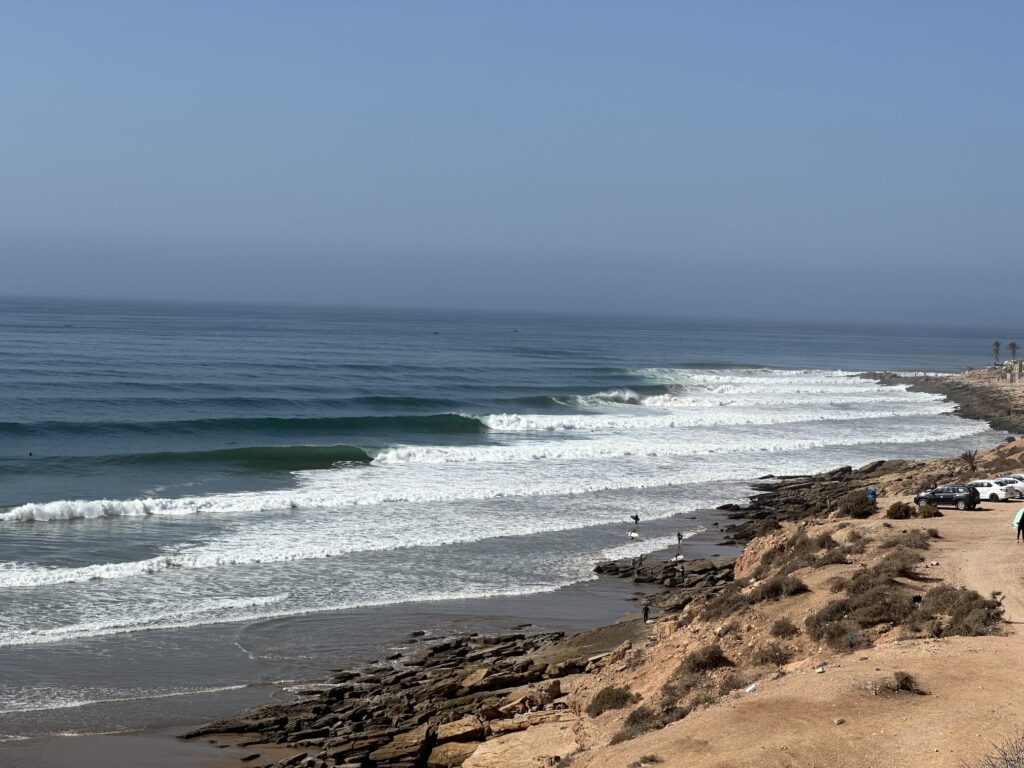
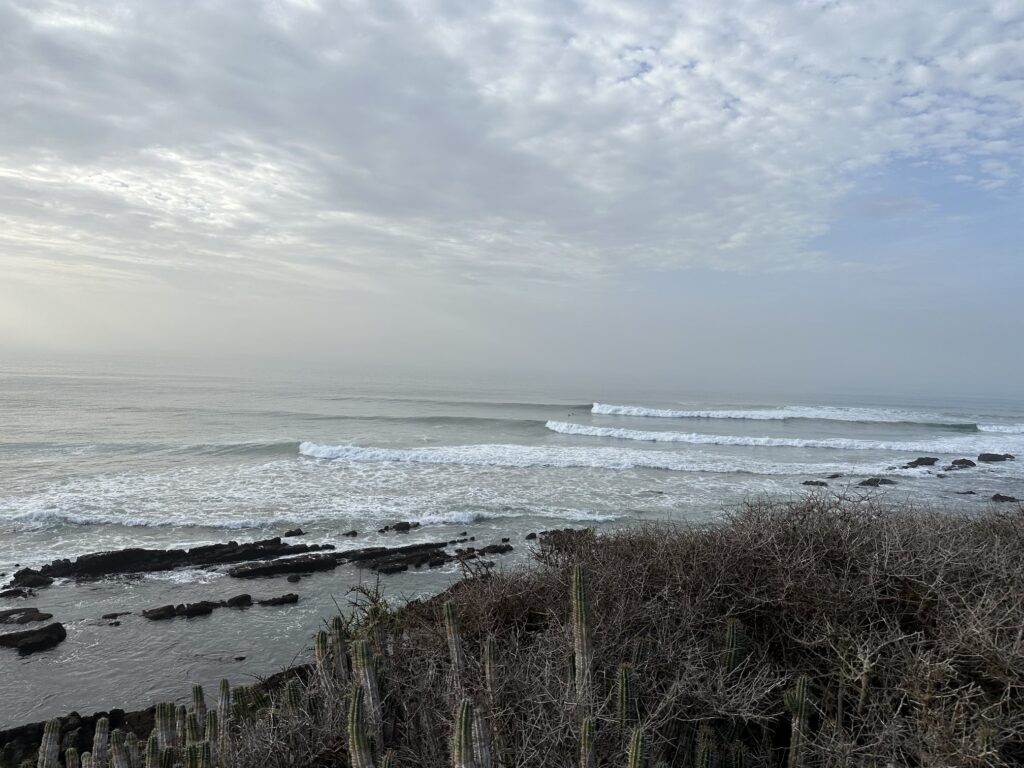
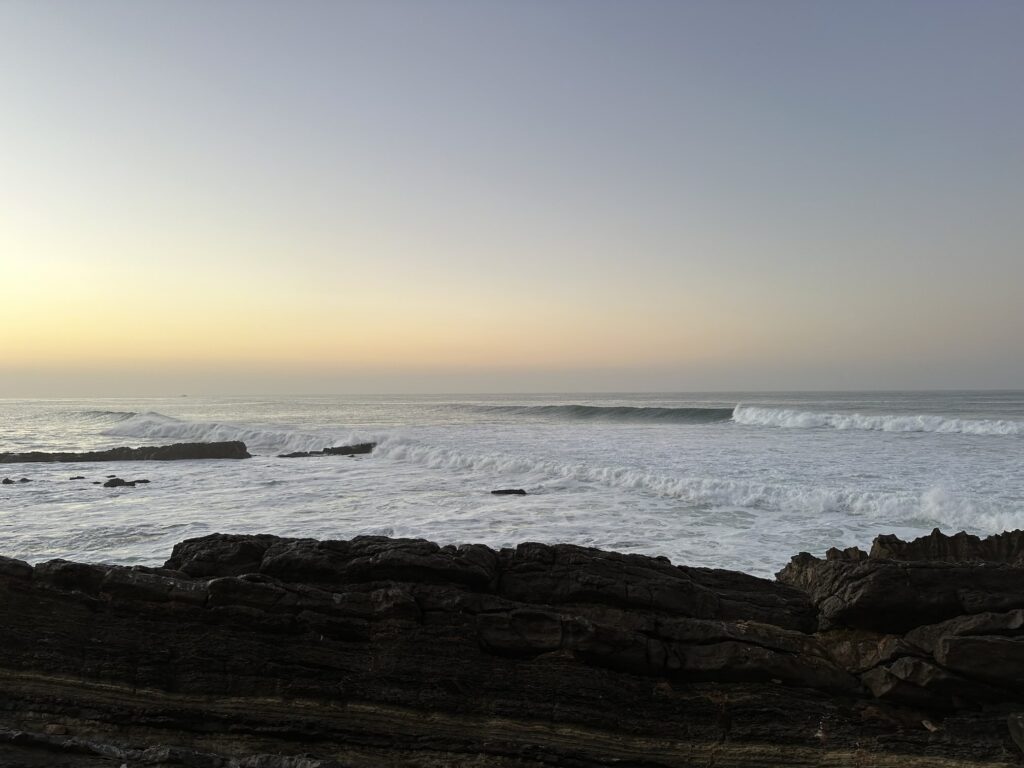
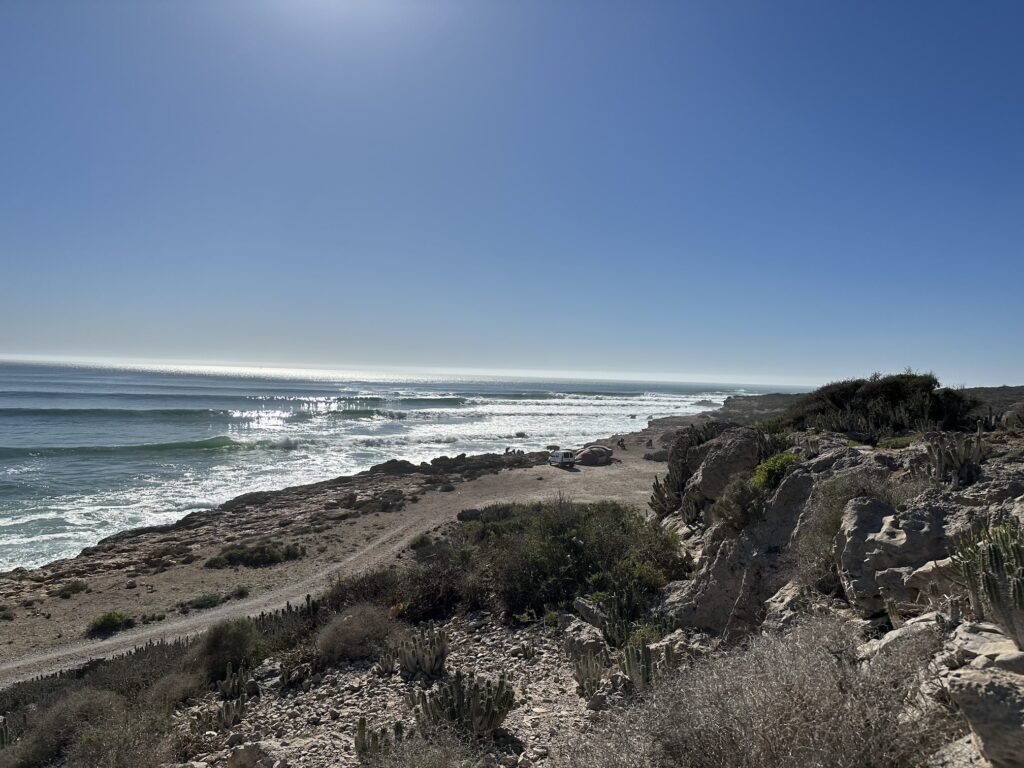
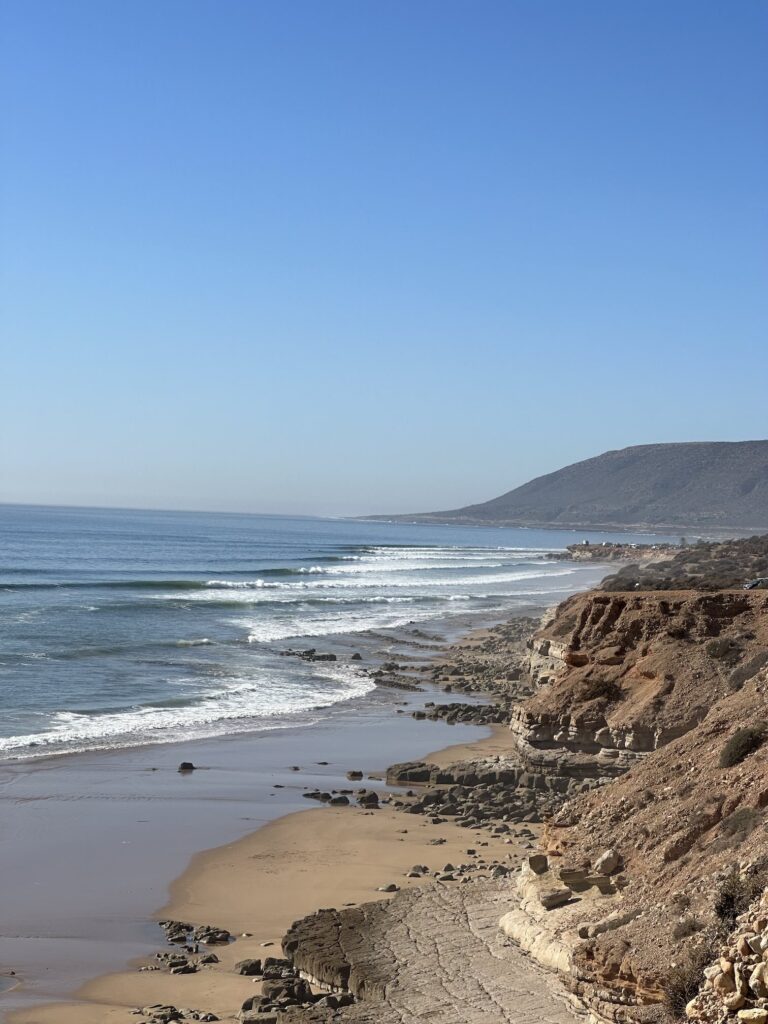
Here’s what you need to know if you want to score solid waves and have a safe trip.
The Morocco Surf Season
The best time to surf Morocco depends on what type of waves you’re looking for.
Intermediate – Advanced Surfers
The biggest swells are in the winter. If you want a good chance of getting overhead surf, plan for the middle of the season.
If you have a car and time to explore, you’ll generally be fine in the shoulder season. Driving 2-3 hours can get you to more exposed coastline when the swell is small.
Beginner – Intermediate Surfers
You can go anytime except in the summer, when most of Morocco’s breaks are flat. The height of the season is fine because you can almost always find places with mellow waves when big swells arrive.
Morocco Weather
The weather is moderate in the winter. Central and south Morocco is a desert; you’re unlikely to see rain, days are warm, and nights can be a little chilly.
Main Surfing Areas & Core Breaks
Like most places the popular breaks near cities get quite crowded, but you can escape the crowds relatively easily with some forecasting knowledge and a car.
Surf Map: Main Breaks of Central & Southern Morocco
Click into each point for more info.
Map Legend
These are general ratings that can vary from day to day based on conditions.
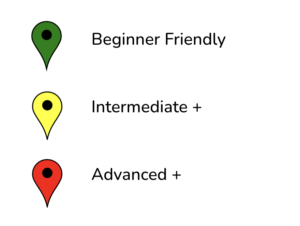
Main Surf Breaks in Central & Southern Morocco
Anchor Point – The Most Famous Wave of Morocco
Anchor Point might be the most famous break in Morocco and therefore is one of the most crowded. The crowd here usually includes a mixture of advanced surfers who dominate the peak and intermediate surfers who line the shoulder looking for waves that swing wide or otherwise pass through unridden.
It’s close to one of the main surf hubs, Tagazhout, which makes it a convenient stop for locals and anyone staying in or near this little city.
Typical rules for surfing crowded point breaks where you’re not a local apply.
Imsuoane – Longboard Heaven
The small town here is known for it’s soft peeling longboard wave and the kind of vibe you would expect from a town full of longboarders. Most people I have met who stayed in Imsuoane went there just as much for the relaxed lifestyle and easy living as they did for the wave.
While you can ride a performance board on bigger swells, or around the corner at Cathedrals, it’s more often a stopover for shortboarders than it is a final destination.
Sidi Ifni & Mirleft – The Less Popular South
If you want less crowds and even warmer weather, you can head south of Agadir. Expect to do a lot more scouting in this area because the breaks are less obvious. But the upside is that they are also less crowded.
Sidi Ifni is a decent-sized city with a reliable break which makes for a good hub. Mirleft is smaller and more peaceful, still has all the amenities you would need, and has several breaks that rarely draw a crowd. The Mirleft breaks generally need a little more swell than further south at Sidi Ifni.
Other Breaks
Check out the map above for the other main breaks. There is a lot of open coastline and plenty of other breaks along the coast.
Forecasting Surf in Morocco
Waves and wind can change significantly just a short drive up or down the coast. Forecasting in Morocco can help you get to the right place at the right time.
What To Watch For
Tides – Almost all breaks are best on a low to mid tide. If there is a lot of swell, mid or even high tide can work at breaks like Anchor Point that can handle the size.
Swell Exposure – North and south of the Agadir-Tagazhout area catch more swell. Typically in the height of the season this isn’t an issue. But occasionally there are weeks where the swell backs off. Having the flexibility to travel north or south will help mitigate this risk of getting skunked in Tagazhout.
Wind Exposure – While heading north or south will get you more swell, it usually also means more wind. While the Tagazhout area is often clean all day, the northern areas can get strong winds in the afternoons.
These are just the general patterns I’ve observed over my 4-month stay. There are always storms and odd weather patterns that will change regional conditions. To maximize your stoke, manage expectations going in and forecast ahead of time so you can make necessary adjustments.
How To Increase Your Chance of Scoring
To maximize your stoke, keep your expectations low but optimize all factors of your trip that will help you get good waves.
Keep these points in mind:
- Give Yourself Time – Unless you have the luxury of dropping your life and flying to Morocco when a swell is on the way, you’re not going to be able to predict a great swell window. There were several weeks during my stay where it was either flat, blown out, or too stormy to surf. If that’s the one week of vacation you have… that’s gonna be a bit of a bummer. The longer you stay the higher chance you have of overlapping your stay with good conditions.
- Forecast Ahead – Taking some time to look at the forecast and compare it to the available cams can help you get a feel for what the waves look like under various conditions. Surfline is not optimized for Morocco, so you can’t just go off their reports, but they do have a few live cams.
- Optimize Your Setup for Flexibility – If you have a car and can manage booking a place to stay at the last minute, then you’ll have the advantage of being able to follow the best conditions. Often times it can be bad winds in one area but offshore two hours away.
- Take A Backup Board – New boards are expensive and the selection is small. Repair shops in Tagazhout are available but there can be a queue that you don’t want to wait in if the waves are pumping.
- Mind The Holiday Rush – Morocco get significantly busier during the end-of-the-year holiday season. There is an influx of surfers around the last couple weeks of December and first few weeks of January.
Logistics
If you have any experience traveling, Morocco will be easy for you. Traffic and navigation is relatively mellow, you’ll have cell service almost everywhere as long as you get a Moroccan sim card, and the people are generally friendly and helpful.
They’re accustomed to having surfers visit for the waves, so you won’t be a novelty to anyone. But you are likely to be asked for money and will potentially be a target for scams. The regular travel precautions are advised.
Renting A Place
Booking your own place is easy. You can find comfortable accommodations through popular sites like Booking or AirBnB. In this regard, it’s pretty standard operations. In all the moderately sized cities, property owners are used to having surfers rent. Places are generally equipped with a modern kitchen, bathroom, and wifi. If you’re going during the late spring, summer, or early fall, you may want to check for air conditioning. During the winter you’ll be fine.
Surf hostels are generally less expensive and a good way to meet other surfers if you’re traveling solo. This can also give you the flexibility to up and move from one day to the next if conditions change.
Surf camps are mostly all-inclusive. This is a good option for the beginner to intermediate surfer. You’ll be grouped with other surfers at your level and taken by van out to a break of your surf guide’s choice. The good thing about the surf camp is that you don’t have to think, you just follow the guides. The downside is that you’re mostly just going to the main breaks along with several other surf camps, so it’s often crowded. (you don’t need a car if you choose to visit via an all-inclusive surf camp)
Renting A Car
If you’re not on a fully guided tour, you need a car. The breaks are spread out, public transit won’t get you to the right breaks at the right time, and taxis will likely be more expensive and more stress than just renting a car.
There are several car rental agencies in Agadir. Most of them will meet you at the Agadir airport.
Book ahead of time and confirm when and where they will meet you. Also clarify what the checkin procedure is. Some agencies will have a car waiting for you in the parking lot which is the most convenient method. Others will pick you up and take you to their office down the road. While these offsite rentals are often cheaper, it’s much more of a hassle.
Communicating
The central and southern areas speak Arabic and French. You’ll find more English in the tourist hubs: Tagazhout, Agadir, surf shops, restaurants, convenience stores, etc.
You can get by without French or Arabic, but a little bit goes a long way. I recommend learning some basic phrases before you go.
Surf’s Up
Whether you head to Morocco or somewhere else… have fun, be generous, and stay safe!